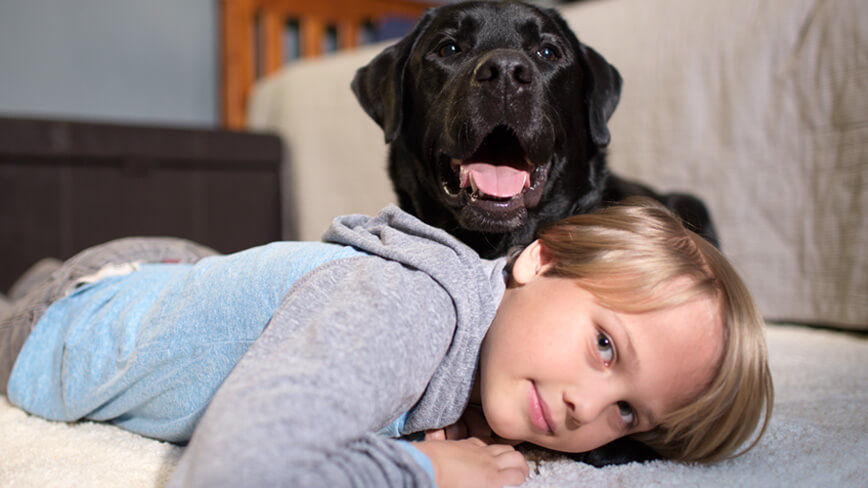Type 1 never rests, so this diabetic alert dog is always ready.
Five-year-old Luke got on a crowded elevator with his mom and black Lab, Jedi. The elevator was quiet until Luke turned to the person beside him and said, “You can’t pet him. He’s working.” Then, after a pause, Luke added, “But you’ve got to pet his ears. They’re so soft.”
Jedi is always working. He’s a diabetic alert dog trained to detect, by smell, drops and rises in Luke’s blood sugar levels. His sense is so acute that he often detects changes before the glucose meter does. He then immediately alerts Luke’s mother, Dorrie. This special skill is just one part of his unique relationship with Luke.
“Luke is really, really proud of Jedi,” says Dorrie. “He is so willing to tell people, ‘I have Type 1 diabetes.’” While some kids with this condition may be embarrassed by it, especially as they get older, Luke (now 8) embraces the fact that he is a little bit different.
“I think Jedi has given Luke this [sense], ‘Yeah, I’m not exactly like you, but I have this really cool dog that is always with me and loves me, and I’m totally OK with that,’” Dorrie adds.
“Jedi makes me brave because he always stands up for me,” Luke says simply.
A constant monitor
Jedi, who is 4, joined the family when he was just a puppy. Dorrie received training from a company that specializes in diabetic alert dogs. “They trained me to train Jedi,” Dorrie says.
When Jedi detects changes in Luke’s blood sugar levels, he tugs a bringsel (a short soft tube, often used by diabetic alert dogs) hanging from Dorrie’s waist and gives it to her to signal that Luke is in need. If he senses that the reading is low (below 80), he bows; if he senses the reading is high (more than 120), he waves his paw. Armed with this information, Dorrie can then check on Luke.
These alerts can come at any time, often at night. One particular night, the family returned from camping. Dorrie checked Luke’s levels, which were fine, and put him to bed. She planned to check Luke again 20 to 30 minutes after unloading the car. That’s when she heard Jedi barking. When she went inside, she saw Jedi standing on the couch by the front door. There were bringsels all over the floor. Something wasn’t right.
“I thought, ‘That’s weird,’ because he doesn’t typically do that,” she says. Dorrie immediately tested Luke. His level had suddenly dropped to 22, low enough to require emergency intervention. Jedi had come through again.

A party animal
Researchers haven’t determined exactly how diabetic alert dogs monitor sugar levels, but they believe it’s based on a dog’s highly developed sense of smell. Jedi can sense a change in Luke’s levels when he’s playing outside or across the street. Jedi has even alerted from as far away as the length of a football field.
“Diabetes likes to sneak up on you when you’re not paying attention,” Dorrie says. “When you assume that everything’s OK, when you’re not thinking about it, when you’re doing something else. That’s where Jedi has helped so much. … [Having Jedi] does allow Luke to play out in the yard, and I can just keep a close eye on Jedi. When Jedi gets ready to alert, then I know I need to do something.”

Whenever Jedi alerts Dorrie, she confirms with a test. When Jedi is right, she praises Jedi by saying “good low” or “good high.” That’s followed by some special recognition: a puppy party.
“The puppy party is his reward,” Dorrie says. “Jedi is motivated by food.” There are fancy treats (dog food or chicken that Dorrie has prepared) for low blood sugars, which can be immediately dangerous. For high blood sugars, he gets dog treats.
And the party doesn’t stop there. The family’s other pets get involved, too.
“When I say ‘good low’ or ‘good high, Jedi,’ I have three other dogs and a cat come because they know that food is coming out of the fridge,” Dorrie says.
Fortunately, Jedi doesn’t mind.
A best friend
The responsibilities aren’t all on Jedi’s side. Luke feeds Jedi and throws the ball for him to keep the dog active. But mostly what Luke and Jedi do is have fun with each other. When Luke is playing with toys or watching TV, Jedi is there. They’re almost always together, even at night, sleeping in the same bed.
Luke and Jedi have also invented their own game. Jedi perches on a low cot while Luke sits on the floor and pushes the underside of the cot with his feet. Then Jedi pounces while Luke keeps moving his feet to different spots. “It’s the silliest thing you’ve ever seen, but they’ll do it every day for a half hour,” Dorrie says.
Perhaps Luke and Jedi get along so well because Jedi isn’t entirely convinced he’s a dog. He sleeps with his head on a pillow, and he carries his stuffed toy around the house. Dorrie calls him “the eternal optimist,” thinking that everyone is there to love him. That includes the cat, Max, who doesn’t completely share his enthusiasm.
“Jedi thinks he’s human,” Dorrie says. “We call him a goof because he’s too big for his body. He wants to sit on your lap, and he doesn’t realize how big he is.” Asked what he would do if Jedi could speak:
“I’d give him a hundred of kisses and a hundred of hugs,” Luke says.
A diabetes ambassador
Although Jedi is focused on (and rewarded for) monitoring Luke, he can sense changing sugar levels in other people. He once alerted at Luke’s school for a classmate who was also Type 1 diabetic. And he has alerted for visitors in their home.
As is appropriate for someone named Jedi (full name: Canine Hope’s Master Jedi Knight), he comes from a distinguished family. Four of his siblings are diabetic alert dogs, and one is a seeing-eye dog. Luke’s diabetic classmate adopted Jedi’s mother. That family lives around the corner in Glendale, California, so Jedi sees her often.
“It’s fun to watch them play,” Dorrie says. Because Dorrie continues to participate in monthly training with Jedi and his siblings have stayed in the area, he still sees members of his “other family.”
In his own way, Jedi has become an ambassador. “[Jedi and Luke] are always together when there’s a major diabetes thing,” Dorrie says. “The dog has really helped people who wouldn’t care before, care. He’s been a doorway for Luke to be able to tell people about diabetes, for us to be able to share stories. It really opens the door for people to learn more.” Even in a crowded elevator.






